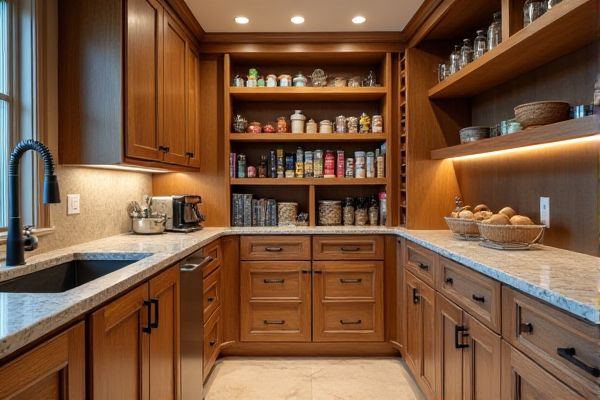
Dry pantry storage relies on ambient room temperature and humidity, making it ideal for non-perishable items that can withstand fluctuating conditions. Climate-controlled pantries regulate temperature and humidity to preserve freshness and extend the shelf life of sensitive foods, ensuring Your ingredients remain in optimal condition. Explore the rest of the article to understand which pantry type best suits your storage needs.
Table of Comparison
| Feature | Dry Pantry Storage | Climate Controlled Pantry |
|---|---|---|
| Temperature Control | No temperature regulation, ambient room temperature | Maintains consistent temperature, typically 50-70degF (10-21degC) |
| Humidity Control | No humidity regulation | Controlled humidity levels, usually 50-60% relative humidity |
| Food Preservation | Suitable for non-perishables like grains, canned goods | Extends shelf life of perishables and delicate items |
| Mold and Pest Prevention | Higher risk due to lack of control | Reduced risk with optimized environment |
| Energy Consumption | Low or none | Consumes energy for climate regulation |
| Cost | Lower initial and operational cost | Higher initial investment and operational cost |
| Best Use Cases | Basic pantry needs, dry goods storage | Premium storage for temperature-sensitive items |
Introduction to Pantry Storage Types
Dry pantry storage offers a traditional solution for keeping non-perishable items like canned goods and grains in a cool, dark environment without humidity control. Climate controlled pantries provide precise temperature and humidity regulation, ideal for preserving fresh produce, craft ingredients, and delicate spices. Choosing the right pantry storage ensures your food maintains optimal freshness and extends shelf life based on your storage needs.
Defining Dry Pantry Storage
Dry pantry storage refers to a designated area for keeping non-perishable food items at room temperature, typically between 50degF and 70degF, in a low-humidity environment to prevent spoilage. It is ideal for storing canned goods, grains, cereals, and spices that do not require refrigeration or precise temperature control. Unlike climate-controlled pantries, dry pantry storage does not regulate temperature or humidity levels, making it a cost-effective solution for long-term food organization.
What Is a Climate Controlled Pantry?
A climate-controlled pantry maintains consistent temperature and humidity levels to preserve the freshness and shelf life of perishable items such as fruits, vegetables, and baked goods. Unlike a dry pantry, which relies on ambient room conditions and is suitable for non-perishable goods like canned foods and grains, a climate-controlled pantry reduces the risk of spoilage and mold growth. Advanced climate-controlled storage systems often include insulation and ventilation to optimize food quality and minimize waste.
Key Differences Between Dry and Climate Controlled Pantries
Dry pantry storage relies on ambient room temperature and low humidity levels to preserve non-perishable items like canned goods, grains, and spices, minimizing moisture exposure to prevent spoilage. Climate-controlled pantries maintain consistent temperature and humidity levels, ideal for storing sensitive items such as fresh produce, chocolate, and certain baked goods, extending shelf life and preserving flavor. Key differences include environmental regulation, with dry pantries offering passive storage solutions, while climate-controlled pantries utilize active systems like thermostats and dehumidifiers for optimal food preservation.
Pros and Cons of Dry Pantry Storage
Dry pantry storage offers long shelf life and protection from moisture, making it ideal for non-perishable foods like grains and canned goods. However, it can be vulnerable to temperature fluctuations and pests, potentially affecting food quality and safety. Unlike climate-controlled pantries, dry storage lacks regulated humidity and temperature, which may shorten the freshness of sensitive items.
Advantages of Climate Controlled Pantry Storage
Climate controlled pantry storage maintains consistent temperature and humidity levels, significantly reducing spoilage and extending the shelf life of perishable items like spices, oils, and nuts. This environment prevents moisture buildup, mold growth, and insect infestations commonly found in dry pantry storage. As a result, food quality, flavor, and nutritional value are preserved longer, offering superior food safety and inventory management.
Impact on Food Shelf Life and Quality
Dry pantry storage typically maintains a stable, low-humidity environment that helps preserve the shelf life of non-perishable items such as grains, cereals, and canned goods by reducing moisture-related spoilage risks. Climate-controlled pantries regulate temperature and humidity more precisely, significantly extending the freshness and quality of sensitive foods like baked goods, fresh produce, and spices by preventing mold growth and staleness. Properly managed climate control can reduce food waste and retain nutritional value longer compared to standard dry storage conditions.
Cost Comparison: Installation and Maintenance
A dry pantry storage system generally has lower installation costs than a climate-controlled pantry, which requires specialized insulation, ventilation, and temperature regulation equipment. Maintenance expenses for a dry pantry are minimal, involving occasional cleaning and pest monitoring, whereas climate-controlled pantries incur higher ongoing costs due to energy consumption and regular HVAC service. Your choice depends on balancing upfront investment with long-term operational expenses while considering the type of food and perishables you need to store.
Best Uses and Items for Each Pantry Type
Dry pantry storage is best suited for non-perishable items such as canned goods, grains, and spices, as it maintains a stable room temperature without humidity control. Climate-controlled pantries are ideal for storing temperature-sensitive items like root vegetables, certain cheeses, and wines, where consistent cool temperatures and higher humidity levels prevent spoilage. Choosing the right pantry type depends on the specific storage needs and the perishability of the food items.
Choosing the Right Pantry Storage for Your Needs
Selecting the right pantry storage depends on the items you plan to store and your home's environment. Dry pantry storage works well for non-perishable goods in stable, low-humidity areas, while climate-controlled pantries maintain consistent temperature and humidity, preserving delicate items like fresh produce or spices. Assess your food storage needs and your kitchen's climate to ensure your pantry setup keeps your ingredients fresh longer and reduces waste.
 homyna.com
homyna.com